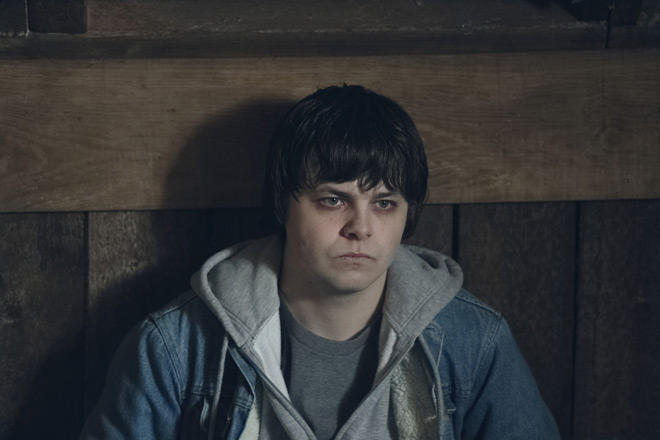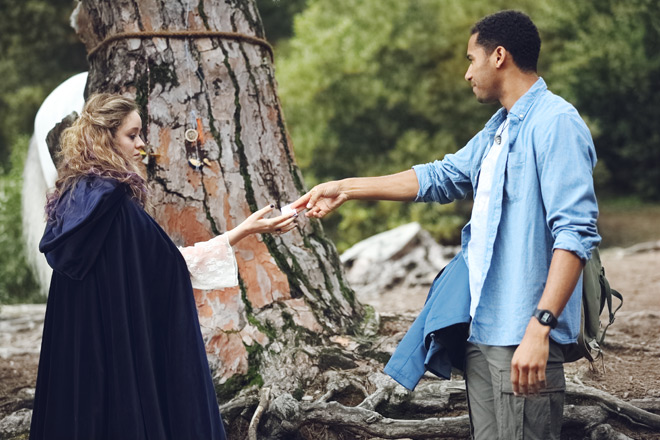Remember Richard Stanley? The man behind 1990’s Hardware? 1992’s Dust Devil? How about 1996’s The Island of Dr. Moreau? On paper, the latter promised to be Stanley’s ascent into Hollywood. Instead, its series of disasters behind the scenes caused Stanley to be fired partway through. Since then he has avoided feature-length fiction in favor of documentaries and short films like 2013’s The Otherworld and 2006’s The Sea of Perdition, respectively.
Well, until this month. Come Friday, January 24, 2020, RLJE Films will release Color Out of Space in theaters. It was directed by Stanley, who also wrote the script alongside Scarlett Amaris (Replace 2017, Blood Bags 2018). Also, yes, it is based on the H.P Lovecraft short story The Colour Out of Space. Oh, and it stars Nicolas Cage (Leaving Las Vegas 1995, The Rock 1996), in case the Dr. Moreau guy and the Cthulhu guy were not a quirky enough combination.

The plot pretty much follows the original story: a mysterious meteorite lands in the front yard of a farm owned by Nathan Gardner (Cage). It glows with a color never seen before on Earth, and this color starts spreading across the farmland, infecting anything that it touches. The Mayor (Q’orianka Kilcher: The New World 2005, Yellowstone series) and the authorities are unable or unwilling to help much. Can Nathan, his wife Theresa (Joely Richardson: Event Horizon 1997, The Patriot 2000) and their kids escape the technicolor nightmare before it gets them too?
The film is about 110 minutes long, while the original story was only about 30 A5-sized pages long. Needless to say, Stanley and Amaris had to make a few changes to beef things up to feature length. Like building up the characters beyond second-hand reports from a surveyor (Elliot Knight: American Gothic series, Titans series), updating the setting to present day rather than the 1920s, etc, while aiming to preserve that unnerving build-up to the horror within. But does it work, or would audiences be better off buying a Lovecraft short story compilation instead?
Well, it is not Stanley’s first rodeo, so the direction is strong. The early scenes are quiet yet set the stage for future terror through establishing shots, such as the family’s reliance on well water or the increasingly odd vegetation. There are some noticeable CGI constructions, but Stanley’s direction makes the most out of them and the more conventional effects. He avoids overexposing the terror in favor of using the right camera angles to emphasize it instead- be they extreme close-ups to play up the grossness, or shots just far enough to obscure details.

How about the acting? When it comes to Cage, on a scale of 1 (2010’s The Sorceror’s Apprentice) to 10 (1997’s Face/Off), the Cage-ometer swings from a 6 to an 8 at peak. He is way more up-tempo than the former, while not quite swallowing the whole scenery like the latter, though he does scoff on more of it as his character develops. Richardson’s Theresa also gradually becomes more unhinged, though out-Caging Cage is a tall order. Tommy Chong (Up in Smoke 1978, That ’70s Show series) also crops up to do his thing as a weird squatter on the Gardner’s property- part stoner, part sign of things to come.
Still, with Cage being Cage and Chong being Chong, it is a bit of a relief that the rest of the cast feels more standard by comparison. Like Julian Hilliard (The Haunting of Hill House 2018, Greener Grass 2019) as the little kid in tune with the horror a la 1982’s Poltergeist. It is left to Knight, Brendan Meyer (The Guest 2014, The OA series) and Madeleine Arthur (Big Eyes 2014, The Magicians series) to be the film’s bedrock of normalcy (or as normal as one can get), and they pull it off well. The latter two start off as perhaps being a little too typically teenybopper-ish, but they do a good job with their material.
Are there any downsides? Well, it is hard to say. The film succeeds at being a technically proficient adaptation of a Lovecraft short story, while adding enough original elements that keep up the horror while rounding it up to feature length. Yet being Lovecraft, the horror treads a fine line between being genuinely horrifying and being quite ridiculous.

Not to mention, perhaps a little familiar as other horror stories- in print, film and beyond- have done their own spin on Color Out of Space’s twist since the original short story’s 1926 publication. For example, 1982’s The Thing may be based on a different story by a different author, but one can see the connections between it and this film. Between that film and Color Out of Space, John Carpenter might have the edge in tension, isolation and making bizarre horror tangible and believable.
That is not to say Color Out of Space cannot stand on its own. If anything, it might be one of the strongest Lovecraft adaptations out there. The film uses its weirdness to its advantage, managing to be a tense and distressing watch all on its own. While it has too many odd moments to be a Thing-beater, it does have enough genuine horror scenes to make par with it. It is a nice highlight for an otherwise quiet season for films. As such, Cryptic Rock gives this film 4 out of 5 stars.





